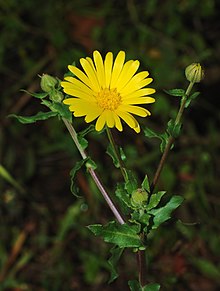Calendula
| Calendula | |
|---|---|
 |
|
| field marigold (Calendula arvensis) | |
| Scientific classification | |
| Kingdom: | Plantae |
| (unranked): | Angiosperms |
| (unranked): | Eudicots |
| (unranked): | Asterids |
| Order: | Asterales |
| Family: | Asteraceae |
| Subfamily: | Asteroideae |
| Tribe: | Calenduleae |
| Genus: |
Calendula L. |
| Species | |
|
See text |
|
See text
Calendula (/kəˈlɛndjuːlə/), is a genus of about 15–20 species of annual and perennial herbaceous plants in the daisy family Asteraceae that are often known as marigolds. They are native to southwestern Asia, western Europe, Macaronesia, and the Mediterranean. Other plants are also known as , such as corn marigold, desert marigold, marsh marigold, and plants of the genus Tagetes. The genus name Calendula is a modern Latin diminutive of calendae, meaning "little calendar", "little clock" or possibly "little weather-glass". The common name "marigold" refers to the Virgin Mary. The most commonly cultivated and used member of the genus is the pot marigold (Calendula officinalis). Popular herbal and cosmetic products named 'calendula' invariably derive from C. officinalis.
Calendula species have been used traditionally as culinary and medicinal herbs. The petals are edible and can be used fresh in salads or dried and used to color cheese or as a replacement for saffron. A yellow dye has been extracted from the flowers.
Romans and Greeks used the golden calendula in many rituals and ceremonies, sometimes wearing crowns or garlands made from the flowers. One of its nicknames is "Mary's Gold," referring to the flowers' use in early Catholic events in some countries. Calendula flowers are sacred flowers in India and have been used to decorate the statues of Hindu deities since early times.
...
Wikipedia
